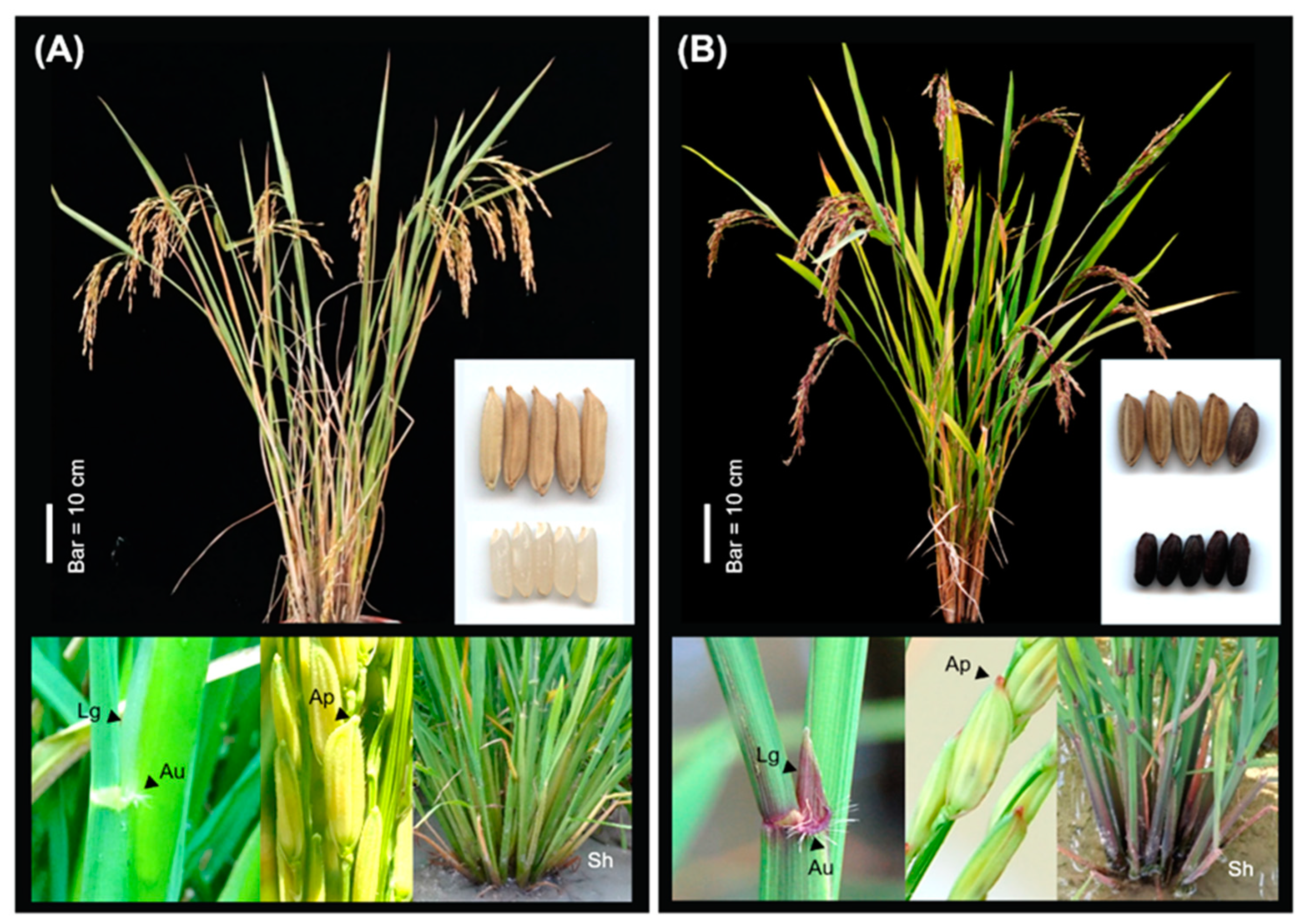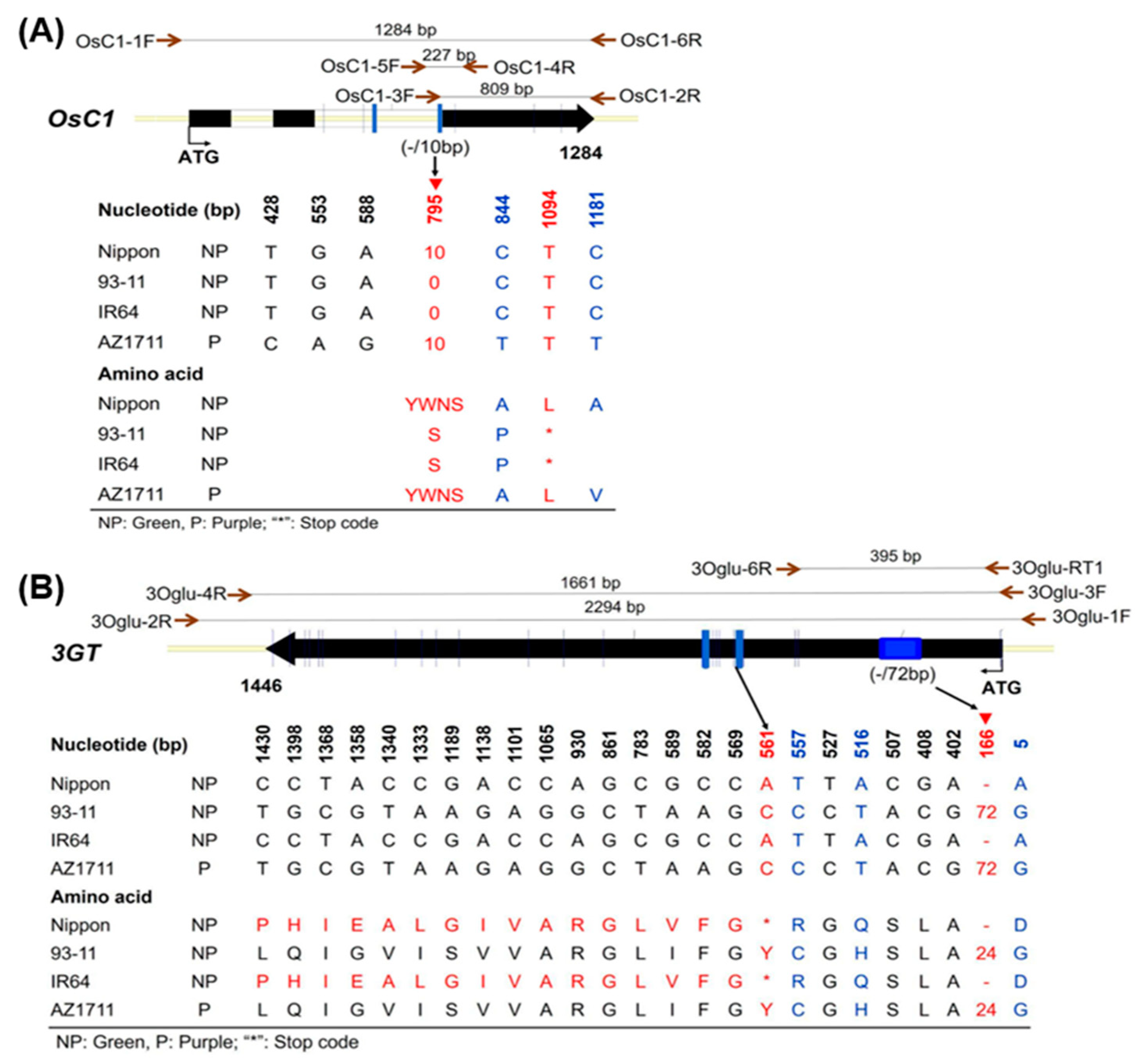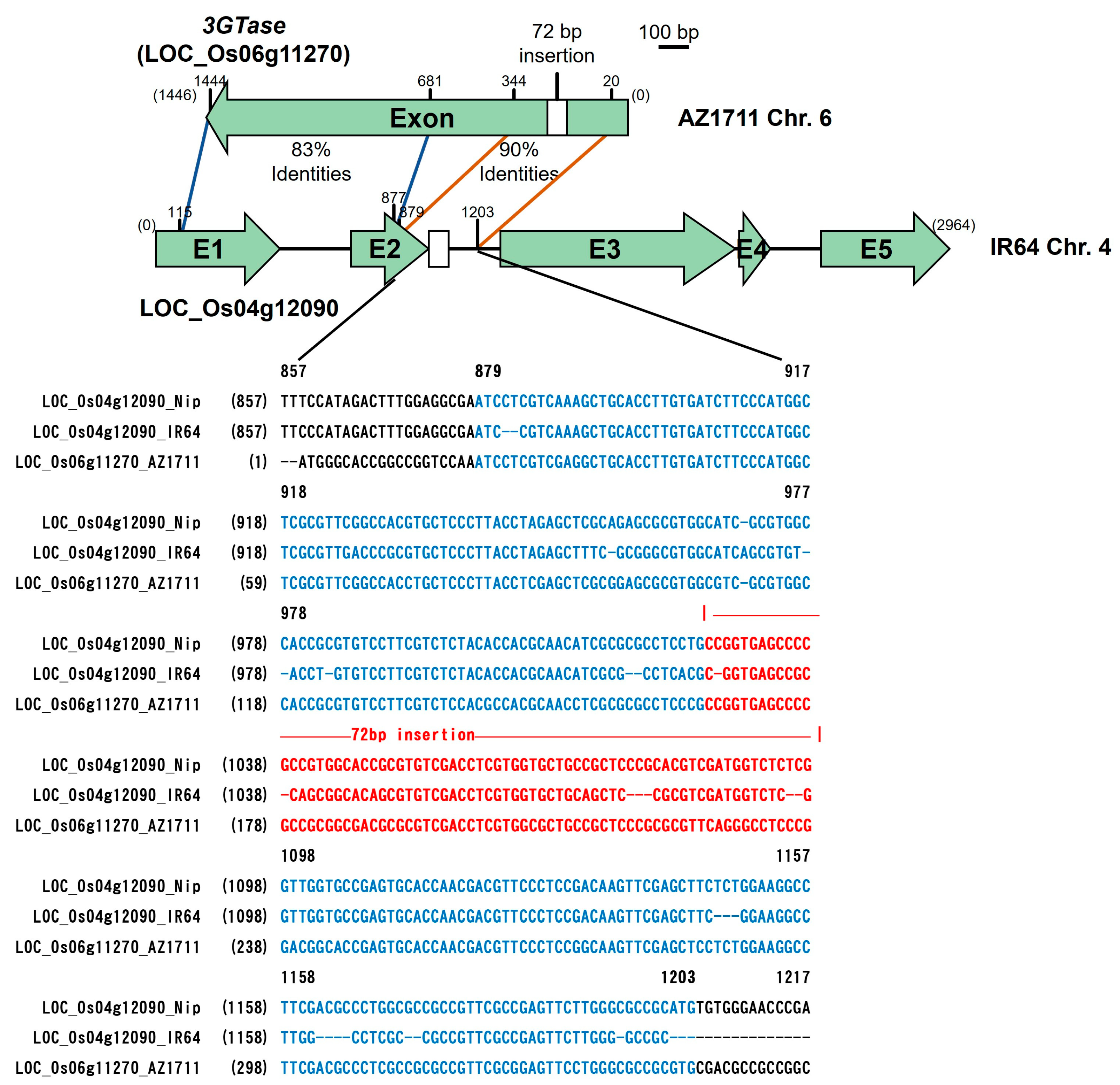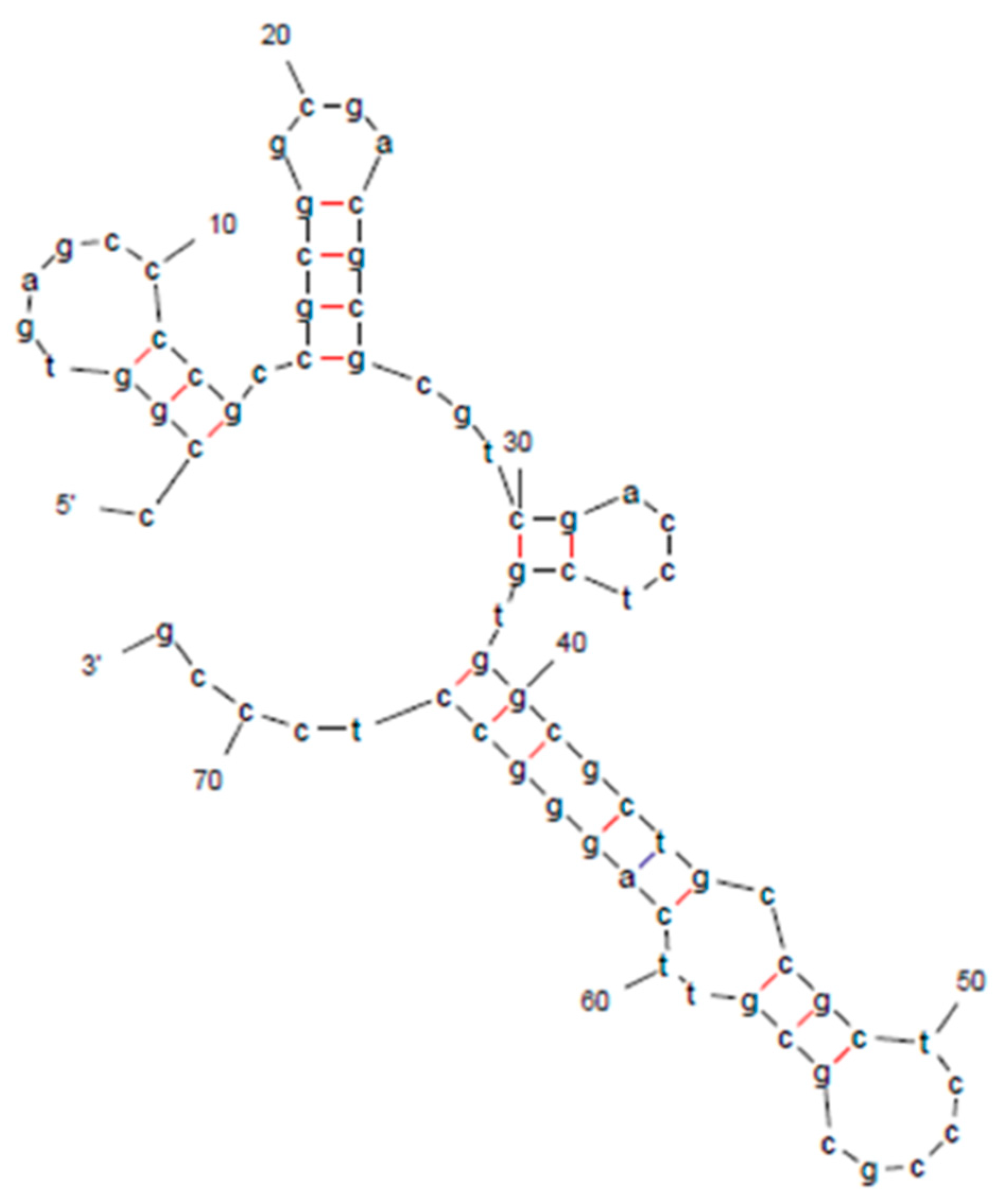Reverse Mutations in Pigmentation Induced by Sodium Azide in the IR64 Rice Variety
Abstract
1. Introduction
2. Materials and Methods
2.1. Mutant Line Selection
2.2. Phenotyping of Tissue Colors
2.3. Establishment of Populations for Genetic Analysis and Linkage Mapping
2.4. DNA Extraction and Genotyping
2.5. Linkage Mapping and Fine Mapping
2.6. Candidate Gene Approach, Cloning, and Sequence Comparison
2.7. Comparison of Sequences and Promoter Prediction
3. Results
3.1. Plant Tissue Pigmentations in Mutants Induced by Sodium Azide
3.2. Genetic Mapping and the Candidate Gene Approach
3.3. Comparison of OsC1, bHLH, and 3GT Sequences in Mutant Lines and the Wild Type
3.4. Identification of Insertion Fragments in the Mutated Genes of Pigmented Lines
4. Discussion
4.1. Identification of a Specific Region for Pigmentation in Rice
4.2. The Characteristics of Mutations Induced by Sodium Azide in AZ1711
4.3. Proposed Mechanisms for Sodium Azide Mutagenesis
5. Conclusions
Supplementary Materials
Author Contributions
Funding
Institutional Review Board Statement
Informed Consent Statement
Data Availability Statement
Acknowledgments
Conflicts of Interest
References
- Sun, X.M.; Zhang, Z.Y.; Chen, C.; Wu, W.; Ren, N.N.; Jiang, C.H.; Yu, J.P.; Zhao, Y.; Zheng, X.M.; Yang, Q.W.; et al. The C–S–A gene system regulates hull pigmentation and reveals evolution of anthocyanin biosynthesis pathway in rice. J. Exp. Bot. 2018, 69, 1485–1498. [Google Scholar] [CrossRef] [PubMed]
- Xia, D.; Zhou, H.; Wang, Y.P.; Li, P.B.; Fu, P.; Wu, B.; He, Y.Q. How rice organs are colored: The genetic basis of anthocyanin biosynthesis in rice. Crop J. 2021, 9, 598–608. [Google Scholar] [CrossRef]
- Liu, Y.; Tikunov, Y.; Schouten, R.E.; Marcelis, L.F.M.; Visser, R.G.F.; Bovy, A. Anthocyanin biosynthesis and degradation mechanisms in Solanaceous vegetables: A review. Front. Chem. 2018, 6, 52. [Google Scholar] [CrossRef] [PubMed]
- Zha, J.; Koffas, M. Production of anthocyanins in metabolically engineered microorganisms: Current status and perspectives. Synth. Syst. Biotechnol. 2017, 2, 259–266. [Google Scholar] [CrossRef] [PubMed]
- Outchkourov, N.S.; Karlova, R.; Hölscher, M.; Schrama, X.; Blilou, I.; Jongedijk, E.; Simon, C.D.; van Dijk, A.D.J.; Bosch, D.; Hall, R.D.; et al. Transcription factor-mediated control of anthocyanin biosynthesis in vegetative tissues. Plant Physiol. 2018, 176, 1862–1878. [Google Scholar] [CrossRef]
- Zhu, Q.L.; Yu, S.Z.; Zeng, D.C.; Liu, H.M.; Wang, H.C.; Yang, Z.F.; Xie, X.R.; Shen, R.X.; Tan, J.T.; Li, H.Y.; et al. Development of “purple endosperm rice” by engineering anthocyanin biosynthesis in the endosperm with a high-efficiency transgene stacking system. Mol. Plant 2017, 10, 918–929. [Google Scholar] [CrossRef]
- Meng, L.Z.; Qi, C.Y.; Wang, C.H.; Wang, S.; Zhou, C.L.; Ren, Y.L.; Cheng, Z.J.; Zhang, X.; Guo, X.P.; Zhao, Z.C.; et al. Determinant factors and regulatory systems for anthocyanin biosynthesis in rice apiculi and stigmas. Rice 2021, 14, 37. [Google Scholar] [CrossRef]
- Khan, R.A.; Abbas, N. Role of epigenetic and post-translational modifications in anthocyanin biosynthesis: A review. Gene 2023, 887, 147694. [Google Scholar] [CrossRef]
- Gruszka, D.; Szarejko, I.; Maluszynski, M. Sodium azide as a mutagen. In Plant Mutation Breeding and Biotechnology; CABI International: Wallingford, UK, 2012; pp. 159–166. [Google Scholar]
- Udage, A. Introduction to plant mutation breeding: Different approaches and mutagenic agents. J. Agric. Sci.-Sri Lanka 2021, 16, 466. [Google Scholar] [CrossRef]
- Wyss, O.; Clark, J.B.; Haas, F.; Stone Wilson, S. The role of peroxide in the biological effects of irradiated broth. J. Bacteriol. 1948, 56, 51–57. [Google Scholar] [CrossRef]
- Ilhan, E.; Kasapoğlu, A.; Türkoğlu, A.; Aygören, A.; Muslu, S.; Aydin, M.; Aldaif, M.; Haliloglu, K. Evaluation of sodium azide as a chemical mutagen in developing cold-tolerant quinoa (Chenopodium quinoa Willd.) lines. Iran. J. Sci. Technology. Trans. A Sci. 2023, 47, 663–671. [Google Scholar] [CrossRef]
- Maan, S.; Brar, J. Mutagenic sensitivity analysis in guava (Psidium guajava L.). Fruits 2021, 76, 181–190. [Google Scholar] [CrossRef]
- Punia, S.; Singh, M.; Grover, G. Tilling: A reverse genetics technique. In Current Innovations in Genetics and Plant Breeding; Tiwari, C., Ed.; Integrated Publications: Delhi, India, 2022; Volume 1, pp. 151–163. [Google Scholar]
- Srivastava, P.; Marker, S.; Pandey, P.; Tiwari, D.K. Mutagenic effects of sodium azide on the growth and yield characteristics in wheat (Triticum aestivum L. em. Thell.). Asian J. Plant Sci. 2011, 10, 190–201. [Google Scholar] [CrossRef][Green Version]
- Horváth, V.; Merenciano, M.; González, J. Revisiting the relationship between transposable elements and the Eukaryotic stress response. TiG 2017, 33, 832–841. [Google Scholar] [CrossRef] [PubMed]
- Liu, Z.; Zhao, H.; Yan, Y.; Wei, M.X.; Zheng, Y.C.; Yue, E.; Alam, M.; Smartt, K.; Duan, M.H.; Xu, J.H. Extensively current activity of transposable elements in natural rice accessions revealed by singleton insertions. Front. Plant Sci. 2021, 12, 745526. [Google Scholar] [CrossRef]
- Hirochika, H.; Sugimoto, K.; Otsuki, Y.; Tsugawa, H.; Kanda, M. Retrotransposons of rice involved in mutations induced by tissue culture. Proc. Natl. Acad. Sci. USA 1996, 93, 7783–7788. [Google Scholar] [CrossRef]
- Rasik, S.; Raina, A.; Laskar, R.A.; Wani, M.R.; Reshi, Z.A.; Khan, S.; Ndhlala, A.R. Lower doses of sodium azide and methyl methanesulphonate improved yield and pigment contents in vegetable cowpea [Vigna unguiculata (L.) Walp.]. S. Afr. J. Bot. 2022, 148, 727–736. [Google Scholar] [CrossRef]
- Türkoğlu, A.; Haliloğlu, K.; Tosun, M.; Szulc, P.; Demirel, F.; Eren, B.; Bujak, H.; Karagöz, H.; Selwet, M.; Özkan, G.; et al. Sodium azide as a chemical mutagen in wheat (Triticum aestivum L.): Patterns of the genetic and epigenetic effects with iPBS and CRED-iPBS techniques. Agriculture 2023, 13, 1242. [Google Scholar] [CrossRef]
- Kobayashi, S.; Goto-Yamamoto, N.; Hirochika, H. Retrotransposon-induced mutations in grape skin color. Science 2004, 304, 982. [Google Scholar] [CrossRef]
- Butelli, E.; Licciardello, C.; Zhang, Y.; Liu, J.J.; Mackay, S.; Bailey, P.; Reforgiato-Recupero, G.; Martin, C. Retrotransposons control fruit-specific, cold-dependent accumulation of anthocyanins in blood oranges. Plant Cell 2012, 24, 1242–1255. [Google Scholar] [CrossRef]
- Lu, T.W.; Chen, W.H.; Chen, P.Y.; Shu, Y.C.; Chen, H.H. Perturbation of periodic spot-generation balance leads to diversified pigmentation patterning of harlequin Phalaenopsis orchids: In silico prediction. BMC Plant Biol. 2024, 24, 681. [Google Scholar] [CrossRef]
- Zheng, J.; Wu, H.; Zhu, H.B.; Huang, C.Y.; Liu, C.; Chang, Y.S.; Kong, Z.C.; Zhou, Z.H.; Wang, G.W.; Lin, Y.J.; et al. Determining factors, regulation system, and domestication of anthocyanin biosynthesis in rice leaves. New Phytol. 2019, 223, 705–721. [Google Scholar] [CrossRef] [PubMed]
- Wang, C.S.; Tseng, T.H.; Lin, C.Y. Rice biotech research at the taiwan agricultural research institute. Asia-Pac. Biotech News 2002, 6, 950–956. [Google Scholar] [CrossRef]
- Jeng, T.L.; Lin, Y.W.; Wang, C.S.; Sung, J.M. Comparisons and selection of rice mutants with high iron and zinc contents in their polished grains that were mutated from the indica type cultivar IR64. J. Food Compos. Anal. 2012, 28, 149–154. [Google Scholar] [CrossRef]
- IRRI. Standard Evaluation System for Rice, 5th ed.; IRRI: Manila, Philippines, 2013. [Google Scholar]
- Doyle, J.J.; Dickson, E.E. Preservation of plant samples for DNA restriction endonuclease analysis. Taxon 1987, 36, 715–722. [Google Scholar] [CrossRef]
- Tseng, H.Y.; Lin, D.G.; Hsieh, H.Y.; Tseng, Y.J.; Tseng, W.B.; Chen, C.W.; Wang, C.S. Genetic analysis and molecular mapping of QTLs associated with resistance to bacterial blight in a rice mutant, SA0423. Euphytica 2015, 205, 231–241. [Google Scholar] [CrossRef]
- Temnykh, S.; DeClerck, G.; Lukashova, A.; Lipovich, L.; Cartinhour, S.; McCouch, S. Computational and experimental analysis of microsatellites in rice (Oryza sativa L.): Frequency, length variation, transposon associations, and genetic marker potential. Genome Res. 2001, 11, 1441–1452. [Google Scholar] [CrossRef]
- McCouch, S.R.; Teytelman, L.; Xu, Y.B.; Lobos, K.B.; Clare, K.; Walton, M.; Fu, B.Y.; Maghirang, R.; Li, Z.K.; Xing, Y.Z.; et al. Development and mapping of 2240 new SSR markers for rice (Oryza sativa L.). DNA Res. 2002, 9, 199–207. [Google Scholar] [CrossRef]
- Broman, K.W.; Wu, H.; Sen, Ś.; Churchill, G.A. R/qtl: QTL mapping in experimental crosses. Bioinformatics 2003, 19, 889–890. [Google Scholar] [CrossRef]
- Akond, Z.; Alam, M.J.; Hasan, M.N.; Uddin, M.S.; Alam, M.; Mollah, M.N.H. A comparison on some interval mapping approaches for QTL detection. Bioinformation 2019, 15, 90–94. [Google Scholar] [CrossRef]
- Lorieux, M. MapDisto: Fast and efficient computation of genetic linkage maps. Mol. Breed. 2012, 30, 1231–1235. [Google Scholar] [CrossRef]
- Takahashi, M. Analysis on apiculus color genes essential to anthocyanin coloration rice. J. Fac. Agric. Hokkaido Univ. 1957, 50, 266–362. [Google Scholar]
- Saitoh, K.; Onishi, K.; Mikami, I.; Thidar, K.; Sano, Y. Allelic diversification at the C (OsC1) locus of wild and cultivated rice: Nucleotide changes associated with phenotypes. Genetics 2004, 168, 997–1007. [Google Scholar] [CrossRef] [PubMed]
- Sweeney, M.T.; Thomson, M.J.; Pfeil, B.E.; McCouch, S. Caught red-handed: Rc encodes a basic helix-loop-helix protein conditioning red pericarp in rice. Plant Cell 2006, 18, 283–294. [Google Scholar] [CrossRef]
- Yang, X.H.; Xia, X.Z.; Zhang, Z.Q.; Nong, B.X.; Zeng, Y.; Wu, Y.Y.; Xiong, F.Q.; Zhang, Y.X.; Liang, H.F.; Pan, Y.H.; et al. Identification of anthocyanin biosynthesis genes in rice pericarp using PCAMP. Plant Biotechnol. J. 2019, 17, 1700–1702. [Google Scholar] [CrossRef]
- Mohan, M.; Nair, S.; Bhagwat, A.; Krishna, T.G.; Yano, M.; Bhatia, C.R.; Sasaki, T. Genome mapping, molecular markers and marker-assisted selection in crop plants. Mol. Breed. 1997, 3, 87–103. [Google Scholar] [CrossRef]
- Young, N.D. Constructing a plant genetic linkage map with DNA markers. In DNA-Based Markers in Plants; Phillips, R.L., Vasil, I.K., Eds.; Springer: Dordrecht, The Netherlands, 1994; pp. 39–57. [Google Scholar]
- Yue, B.; Cui, K.H.; Yu, S.B.; Xue, W.Y.; Luo, L.J.; Xing, Y.Z. Molecular marker-assisted dissection of quantitative trait loci for seven morphological traits in rice (Oryza sativa L.). Euphytica 2006, 150, 131–139. [Google Scholar] [CrossRef]
- Olsen, O.; Wang, X.; von Wettstein, D. Sodium azide mutagenesis: Preferential generation of AT-->GC transitions in the barley Ant18 gene. Proc. Natl. Acad. Sci. USA 1993, 90, 8043–8047. [Google Scholar] [CrossRef]
- Dooner, H.K.; Robbins, T.P.; Jorgensen, R.A. Genetic and developmental control of anthocyanin biosynthesis. Annu. Rev. Genet. 1991, 25, 173–199. [Google Scholar] [CrossRef]
- Koes, R.; Verweij, W.; Quattrocchio, F. Flavonoids: A colorful model for the regulation and evolution of biochemical pathways. Trends Plant Sci. 2005, 10, 236–242. [Google Scholar] [CrossRef]
- Grotewold, E. The genetics and biochemistry of floral pigments. Annu. Rev. Plant Biol. 2006, 57, 761–780. [Google Scholar] [CrossRef] [PubMed]
- Ishikawa, R.; Castillo, C.C.; Fuller, D.Q. Genetic evaluation of domestication-related traits in rice: Implications for the archaeobotany of rice origins. Archaeol. Anthropol. Sci. 2020, 12, 197. [Google Scholar] [CrossRef]
- Choudhury, B.I.; Khan, M.L.; Dayanandan, S. Patterns of nucleotide diversity and phenotypes of two domestication related genes (OsC1 and Wx) in indigenous rice varieties in Northeast India. BMC Genet. 2014, 15, 71. [Google Scholar] [CrossRef] [PubMed]
- Qiao, W.H.; Wang, Y.Y.; Xu, R.; Yang, Z.Y.; Sun, Y.; Su, L.; Zhang, L.Z.; Wang, J.R.; Huang, J.F.; Zheng, X.M.; et al. A functional chromogen gene C from wild rice is involved in a different anthocyanin biosynthesis pathway in indica and japonica. Theor. Appl. Genet. 2021, 134, 1531–1543. [Google Scholar] [CrossRef] [PubMed]
- Shatunov, A.; Olivé, M.; Odgerel, Z.; Stadelmann-Nessler, C.; Irlbacher, K.; van Landeghem, F.; Bayarsaikhan, M.; Lee, H.S.; Goudeau, B.; Chinnery, P.F.; et al. In-frame deletion in the seventh immunoglobulin-like repeat of filamin C in a family with myofibrillar myopathy. Eur. J. Hum. Genet. 2009, 17, 656–663. [Google Scholar] [CrossRef]
- Wang, C.S.; Lo, K.L.; Wang, A.Z. Sodium azide mutagenesis generated diverse and broad spectrum blast resistance mutants in rice. Euphytica 2019, 215, 145. [Google Scholar] [CrossRef]
- Kleinhofs, A.; Smith, J.A. Effect of excision repair on azide-induced mutagenesis. Mutat. Res. 1976, 41, 233–239. [Google Scholar] [CrossRef]
- Thomas, H.T.; Areum, C.; Isabelle, M.H.; Kathie, J.N.; Diana, B.-W. Effectiveness of sodium azide alone compared to sodium azide in combination with methyl nitrosurea for rice mutagenesis. Plant Breed. Biotechnol. 2016, 4, 453–461. [Google Scholar] [CrossRef]
- Viana, V.E.; Pegoraro, C.; Busanello, C.; Costa de Oliveira, A. Mutagenesis in rice: The basis for breeding a new super plant. Front. Plant Sci. 2019, 10, 1326. [Google Scholar] [CrossRef]
- Lu, Y.Q.; Xu, Y.Z.; Li, N. Early domestication history of Asian rice revealed by mutations and genome-wide analysis of gene genealogies. Rice 2022, 15, 11. [Google Scholar] [CrossRef]
- Stein, J.C.; Yu, Y.S.; Copetti, D.; Zwickl, D.J.; Zhang, L.; Zhang, C.J.; Chougule, K.; Gao, D.Y.; Iwata, A.; Goicoechea, J.L.; et al. Genomes of 13 domesticated and wild rice relatives highlight genetic conservation, turnover and innovation across the genus Oryza. Nat. Genet. 2018, 50, 285–296. [Google Scholar] [CrossRef] [PubMed]
- Zhu, Y.W.; Lin, Y.R.; Chen, S.B.; Liu, H.Q.; Chen, Z.J.; Fan, M.Y.; Hu, T.J.; Mei, F.T.; Chen, J.M.; Chen, L.; et al. CRISPR/Cas9-mediated functional recovery of the recessive rc allele to develop red rice. Plant Biotechnol. J. 2019, 17, 2096–2105. [Google Scholar] [CrossRef] [PubMed]
- Banakar, R.; Eggenberger, A.L.; Lee, K.; Wright, D.A.; Murugan, K.; Zarecor, S.; Lawrence-Dill, C.J.; Sashital, D.G.; Wang, K. High-frequency random DNA insertions upon co-delivery of CRISPR-Cas9 ribonucleoprotein and selectable marker plasmid in rice. Sci. Rep. 2019, 9, 19902. [Google Scholar] [CrossRef] [PubMed]
- Gong, W.K.; Zhou, Y.; Wang, R.; Wei, X.L.; Zhang, L.; Dai, Y.; Zhu, Z. Analysis of T-DNA integration events in transgenic rice. J. Plant Physiol. 2021, 266, 153527. [Google Scholar] [CrossRef] [PubMed]
- Garg, M.; Poornima, G.; Rajyaguru, P.I. Elucidation of the RNA-granule inducing sodium azide stress response through transcriptome analysis. Genomics 2020, 112, 2978–2989. [Google Scholar] [CrossRef] [PubMed]
- Wilson, D.F.; Chance, B. Azide inhibition of mitochondrial electron transport I. The aerobic steady state of succinate oxidation. Biochim. Biophys. Acta Bioenerg. 1967, 131, 421–430. [Google Scholar] [CrossRef]
- Carpentier, M.-C.; Manfroi, E.; Wei, F.J.; Wu, H.P.; Lasserre, E.; Llauro, C.; Debladis, E.; Akakpo, R.; Hsing, Y.I.; Panaud, O. Retrotranspositional landscape of Asian rice revealed by 3000 genomes. Nat. Commun. 2019, 10, 24. [Google Scholar] [CrossRef]
- Oladosu, Y.; Rafii, M.Y.; Abdullah, N.; Hussin, G.; Ramli, A.; Rahim, H.A.; Miah, G.; Usman, M. Principle and application of plant mutagenesis in crop improvement: A review. Biotechnol. Biotechnol. Equip. 2016, 30, 1–16. [Google Scholar] [CrossRef]
- McClintock, B. The origin and behavior of mutable loci in maize. Proc. Natl. Acad. Sci. USA 1950, 36, 344–355. [Google Scholar] [CrossRef]
- Roland, A.; Marie-Christine, C.; Hsing, Y.I.; Olivier, P. The impact of transposable elements on the structure, evolution and function of the rice genome. New Phytol. 2020, 226, 44–49. [Google Scholar] [CrossRef]
- Ishikawa, S.; Ishimaru, Y.; Igura, M.; Kuramata, M.; Abe, T.; Senoura, T.; Hase, Y.; Arao, T.; Nishizawa, N.K.; Nakanishi, H. Ion-beam irradiation, gene identification, and marker-assisted breeding in the development of low-cadmium rice. Proc. Natl. Acad. Sci. USA 2012, 109, 19166–19171. [Google Scholar] [CrossRef] [PubMed]
- Miyao, A.; Tanaka, K.; Murata, K.; Sawaki, H.; Takeda, S.; Abe, K.; Shinozuka, Y.; Onosato, K.; Hirochika, H. Target site specificity of the Tos17 retrotransposon shows a preference for insertion within genes and against insertion in retrotransposon-rich regions of the genome. Plant Cell 2003, 15, 1771–1780. [Google Scholar] [CrossRef] [PubMed]
- Farkash, E.A.; Prak, E.T.L. DNA damage and L1 retrotransposition. J. Biomed. Biotechnol. 2006, 2006, 037285. [Google Scholar] [CrossRef] [PubMed]
- Kikuchi, K.; Terauchi, K.; Wada, M.; Hirano, H.Y. The plant MITE mPing is mobilized in anther culture. Nature 2003, 421, 167–170. [Google Scholar] [CrossRef] [PubMed]
- Li, X.; Heyer, W.-D. Homologous recombination in DNA repair and DNA damage tolerance. Cell Res. 2008, 18, 99–113. [Google Scholar] [CrossRef]
- Ray, A.; Langer, M. Homologous recombination: Ends as the means. Trends Plant Sci. 2002, 7, 435–440. [Google Scholar] [CrossRef]
- Colot, V.; Haedens, V.; Rossignol, J.-L. Extensive, nonrandom diversity of excision footprints generated by Ds-Like transposon Ascot-1 suggests new parallels with V(D)J recombination. Mol. Cell. Biol. 1998, 18, 4337–4346. [Google Scholar] [CrossRef]
- Pannunzio, N.R.; Watanabe, G.; Lieber, M.R. Nonhomologous DNA end-joining for repair of DNA double-strand breaks. J. Biol. Chem. 2018, 293, 10512–10523. [Google Scholar] [CrossRef]
- Datta, A.; Hendrix, M.; Lipsitch, M.; Jinks-Robertson, S. Dual roles for DNA sequence identity and the mismatch repair system in the regulation of mitotic crossing-over in yeast. Proc. Natl. Acad. Sci. USA 1997, 94, 9757–9762. [Google Scholar] [CrossRef]
- Sukegawa, S.; Toki, S.; Saika, H. Genome editing technology and its application to metabolic engineering in rice. Rice 2022, 15, 21. [Google Scholar] [CrossRef]







| Plant | Tissue Phenotype a | ||||
|---|---|---|---|---|---|
| Leaf-Sheath | Auricle | Ligule | Apiculus | ||
| IR64 | G | G | G | G | |
| AZ1701 | P | LP | P | R | |
| AZ1702 | P | LG | P | R | |
| AZ1711 | P | LP | P | R | |
| AZ1714 | LP | P | P | R | |
| AZ1715 | P | P | P | R | |
| AZ1701×IR64 F1 | P | LP | LP | R | |
| AZ1702×IR64 F1 | P | LP | LP | R | |
| AZ1711×IR64 F1 | P | P | P | P | |
| AZ1714×IR64 F1 | P | P | P | R | |
| AZ1715×IR64 F1 | P | P | P | R | |
| AZ1711×IR64 F2 | Pig: Non-pig b | 402:155 | 401:156 | 400:157 | 401:156 |
| Tested ratio | 3:1 | 3:1 | 3:1 | 3:1 | |
| χ2 | 2.45 ns | 2.77 ns | 3.10 ns | 2.77 ns | |
| Marker | p-Value a | R2 b | A c | D d | |D/A| e |
|---|---|---|---|---|---|
| RM6773 | 1.41 × 10−11 | 0.43 | −0.33 | 0.34 | 1.02 |
| RM5754 | 2.11 × 10−11 | 0.42 | −0.36 | 0.3 | 0.83 |
| RM253 | 7.24 × 10−31 | 0.78 | −0.45 | 0.46 | 1.03 |
| RM2615 | 2.78 × 10−18 | 0.59 | −0.40 | 0.37 | 0.94 |
| Gene | MSU ID | BGI ID | Annotation |
|---|---|---|---|
| OsC1 | LOC_Os06g10350 | BGIOSGA022508 | MYB family transcription factor |
| bHLH | LOC_Os06g10820 | BGIOSGA022533 | helix-loop-helix DNA-binding domain-containing protein |
| 3GT | LOC_Os06g11270 | BGIOSGA021671 | anthocyanidin 3-O-glucosyltransferase |
| Plant | RM5754 | C | OsC1 | RM253 | S | G | 3Oglu | RM2615 | Phenotype |
|---|---|---|---|---|---|---|---|---|---|
| AZ1711 | AA | CC | AA | AA | SS | GG | AA | AA | Purple |
| AZ1711×IR64 F1 a | AB | Cc | AB | AB | SS | Gg | AB | AB | Purple |
| F2 P13 | AA | CC | AA | AA | SS | GG | AA | AA | Purple |
| F2 G11 | AB | cc | BB | BB | SS | gg | BB | BB | Green |
| F2 G15 | BB | cc | BB | BB | SS | Gg | AB | AB | Green |
| IR64 | BB | cc | BB | BB | SS | gg | BB | BB | Green |
Disclaimer/Publisher’s Note: The statements, opinions and data contained in all publications are solely those of the individual author(s) and contributor(s) and not of MDPI and/or the editor(s). MDPI and/or the editor(s) disclaim responsibility for any injury to people or property resulting from any ideas, methods, instructions or products referred to in the content. |
© 2024 by the authors. Licensee MDPI, Basel, Switzerland. This article is an open access article distributed under the terms and conditions of the Creative Commons Attribution (CC BY) license (https://creativecommons.org/licenses/by/4.0/).
Share and Cite
Chen, H.-J.; Sawasdee, A.; Lin, Y.-L.; Chiang, M.-Y.; Chang, H.-Y.; Li, W.-H.; Wang, C.-S. Reverse Mutations in Pigmentation Induced by Sodium Azide in the IR64 Rice Variety. Curr. Issues Mol. Biol. 2024, 46, 13328-13346. https://doi.org/10.3390/cimb46120795
Chen H-J, Sawasdee A, Lin Y-L, Chiang M-Y, Chang H-Y, Li W-H, Wang C-S. Reverse Mutations in Pigmentation Induced by Sodium Azide in the IR64 Rice Variety. Current Issues in Molecular Biology. 2024; 46(12):13328-13346. https://doi.org/10.3390/cimb46120795
Chicago/Turabian StyleChen, Hsian-Jun, Anuchart Sawasdee, Yu-Ling Lin, Min-Yu Chiang, Hsin-Yi Chang, Wen-Hsiung Li, and Chang-Sheng Wang. 2024. "Reverse Mutations in Pigmentation Induced by Sodium Azide in the IR64 Rice Variety" Current Issues in Molecular Biology 46, no. 12: 13328-13346. https://doi.org/10.3390/cimb46120795
APA StyleChen, H.-J., Sawasdee, A., Lin, Y.-L., Chiang, M.-Y., Chang, H.-Y., Li, W.-H., & Wang, C.-S. (2024). Reverse Mutations in Pigmentation Induced by Sodium Azide in the IR64 Rice Variety. Current Issues in Molecular Biology, 46(12), 13328-13346. https://doi.org/10.3390/cimb46120795






